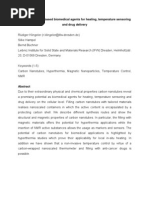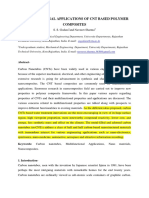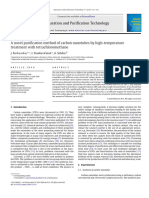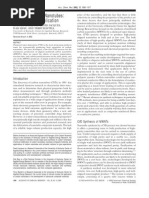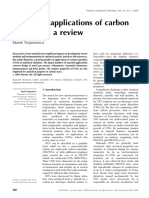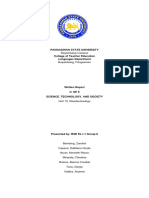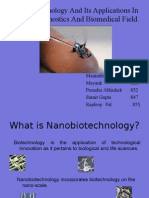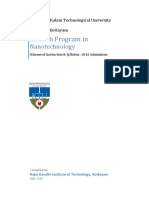Carbon Clusters, Fullerenes, and Nanotubes
Carbon Clusters, Fullerenes, and Nanotubes
Uploaded by
j_elenduCopyright:
Available Formats
Carbon Clusters, Fullerenes, and Nanotubes
Carbon Clusters, Fullerenes, and Nanotubes
Uploaded by
j_elenduOriginal Description:
Original Title
Copyright
Available Formats
Share this document
Did you find this document useful?
Is this content inappropriate?
Copyright:
Available Formats
Carbon Clusters, Fullerenes, and Nanotubes
Carbon Clusters, Fullerenes, and Nanotubes
Uploaded by
j_elenduCopyright:
Available Formats
car02613_ch11_428-477.
indd Page 440 11/20/09 10:38:57 AM elhi3
440
Chapter 11
/Users/elhi3/Documents/Smart Connection/InDesign/41332
Arenes and Aromaticity
Carbon Clusters, Fullerenes, and Nanotubes
In general, the term nanoscale applies to dimensions on the
order of 1100 nanometers (1 nm 109 m), and one goal of
nanotechnology is to develop useful nanoscale devices (nanodevices). Because typical covalent bonds range from 0.10.2 nm,
chemical structures hold promise as candidates on which to
base nanodevices. Among them, much recent attention has
been given to carbon-containing materials and even elemental
carbon itself.
Until 1985, chemists recognized two elementary forms
(allotropes) of carbon: diamond and graphite. Then, Professors Harold W. Kroto (University of Sussex), Robert F. Curl,
and Richard E. Smalley (both of Rice University) reported that
laser-induced evaporation of graphite gave a species with a
molecular formula of C60 and proposed the spherical cluster
of carbon atoms now called buckminsterfullerene (Figure 11.5)
for it. Other closed carbon clusters, some larger than C60 and
some smaller, were also formed in the experiment. These forms
of carbon are now known as fullerenes, and Kroto, Smalley,
and Curl were awarded the 1996 Nobel Prize in Chemistry for
discovering them.
Figure 11.5
Buckminsterfullerene (C60). All of the carbon atoms are equivalent
and are sp2 -hybridized; each one simultaneously belongs to one fivemembered ring and two benzene-like six-membered rings.
Figure 11.6
A single-walled carbon nanotube (SWCNT). SWCNTs can be regarded
as a two-dimensional graphite sheet rolled into a cylinder. Credit: The
single-walled carbon nanotube in Figure 11.6 is from the Spartan model
provided by Dr. Warren J. Hehre of Wavefunction, Inc.
Research on fullerenes carried out at NEC Corporation
(Japan) and at IBM (United States) led in 1991 to the isolation
of fibrous clusters of single-walled carbon nanotubes (SWCNTs)
(Figure 11.6). SWCNTs have since been joined by multiwalled
carbon nanotubes (MWCNTs) (Figure 11.7) as well as nanotubes
containing elements other than carbon.
CNTs themselves are of interest because of their electrical
and mechanical properties, and functionally modified ones are
being examined in applications ranging from medical diagnosis and therapy to photovoltaic systems. The methods used to
add functionality to a CNT include among others: (1) covalent
attachment of a reactive group to the CNT via a chemical reaction, and (2) noncovalent coating of the outer surface of the CNT
with a substance that itself bears a functional substituent.
Continued
inexpensive organic solvent because it has similar solvent properties but has not been
determined to be carcinogenic in the cell systems and at the dose levels that benzene is.
11.9 Reactions of Arenes: A Preview
Well examine the chemical properties of aromatic compounds from two different
perspectives:
1. One mode of chemical reactivity involves the ring itself as a functional group and
includes
(a) Reduction and oxidation
(b) Electrophilic aromatic substitution
Reduction of arenes by catalytic hydrogenation was described in Section 11.3. A different
method using Group 1 metals as reducing agents, which gives 1,4-cyclohexadiene derivatives, will be presented in Section 11.10. Oxidations of aromatic compounds are discussed in
Chapter 22. Electrophilic aromatic substitution is the most important reaction type exhibited by benzene and its derivatives and constitutes the entire subject matter of Chapter 12.
You might also like
- Graphene Nanoelectronics: Metrology, Synthesis, Properties and ApplicationsDocument611 pagesGraphene Nanoelectronics: Metrology, Synthesis, Properties and ApplicationsAnonymous qP6XqGzj6100% (3)
- 7000 Technical Ebooks Free Download (Links)Document572 pages7000 Technical Ebooks Free Download (Links)Javed Mohammed50% (2)
- The History of NanomaterialsDocument20 pagesThe History of NanomaterialsViannet RH100% (2)
- Semiconductor ManufacturingDocument238 pagesSemiconductor ManufacturingMustafa Liqa-Madiq IV Azoulaye100% (5)
- Carbon NanotubeDocument23 pagesCarbon NanotubeDiavolo RequiemNo ratings yet
- Carbon Nanotubes - 2018 (MWCNT)Document60 pagesCarbon Nanotubes - 2018 (MWCNT)Vicky SharmaNo ratings yet
- The Biocompatibility of Carbon NanotubesDocument14 pagesThe Biocompatibility of Carbon NanotubesManuel QuistialNo ratings yet
- SeminarDocument23 pagesSeminarRaneena RaoofNo ratings yet
- Carbon Nanomaterials SynthesisDocument21 pagesCarbon Nanomaterials SynthesisebayNo ratings yet
- A Brief Introduction of Carbon Nanotubes History SDocument10 pagesA Brief Introduction of Carbon Nanotubes History SRafi Wiransyah100% (1)
- Effect of Induced Vacancy Defects On The Mechanical Behavior of WavyDocument9 pagesEffect of Induced Vacancy Defects On The Mechanical Behavior of WavyLarissa VourlisNo ratings yet
- Electronic Properties of Single-Wall Carbon Nanotubes and Their Dependence On Synthetic MethodsDocument5 pagesElectronic Properties of Single-Wall Carbon Nanotubes and Their Dependence On Synthetic MethodsGurpartap SinghNo ratings yet
- Carbon Nanotubes-Properties and Applications - A ReviewDocument14 pagesCarbon Nanotubes-Properties and Applications - A ReviewIBN E MARYAMNo ratings yet
- carbon nanatubeDocument18 pagescarbon nanatubedel44108No ratings yet
- Materials Science & Engineering C: V.R. Raphey, T.K. Henna, K.P. Nivitha, P. Mufeedha, Chinnu Sabu, K. Pramod TDocument15 pagesMaterials Science & Engineering C: V.R. Raphey, T.K. Henna, K.P. Nivitha, P. Mufeedha, Chinnu Sabu, K. Pramod THenna TkNo ratings yet
- Unit Vi Chemistry of Advenced Materials: Rev - Ed. 2014-15Document47 pagesUnit Vi Chemistry of Advenced Materials: Rev - Ed. 2014-15ASumeethKumarNo ratings yet
- Chemistry and Physics in One Dimension: Synthesis and Properties of Nanowires and NanotubesDocument11 pagesChemistry and Physics in One Dimension: Synthesis and Properties of Nanowires and Nanotubesscribd51015No ratings yet
- NanomaterialsDocument10 pagesNanomaterialsDorothy SaikiaNo ratings yet
- Carbon Nanotubes: Himanshu Tyagi, Diwakar Prasad, Deepak Kumar, DR - Leena AryaDocument4 pagesCarbon Nanotubes: Himanshu Tyagi, Diwakar Prasad, Deepak Kumar, DR - Leena AryaRavindra KumarNo ratings yet
- sakshi petkarDocument17 pagessakshi petkarsonalramteke2509No ratings yet
- Synthesis, Characterization and Applications of Carbon Nanotubes A ReviewDocument6 pagesSynthesis, Characterization and Applications of Carbon Nanotubes A ReviewEditor IJTSRDNo ratings yet
- Fchem 03 00059Document21 pagesFchem 03 00059María Camila Bermúdez JaimesNo ratings yet
- Article 4 Nanotechnology For Implantablesensors Carbon Nanotube and Graphene in MedicineDocument17 pagesArticle 4 Nanotechnology For Implantablesensors Carbon Nanotube and Graphene in MedicineJULIANA CORTES GARCIANo ratings yet
- Review Hyperthermia v11bDocument21 pagesReview Hyperthermia v11bspokenfearNo ratings yet
- Carbon 10 00069Document19 pagesCarbon 10 0006921wh1a0448No ratings yet
- J. J. Davis, K. S. Coleman Et Al.: 2003 Wiley-Vch Verlag GMBH & Co. Kgaa, Weinheim Chem. Eur. J. 2003, 9, 3732 3739Document8 pagesJ. J. Davis, K. S. Coleman Et Al.: 2003 Wiley-Vch Verlag GMBH & Co. Kgaa, Weinheim Chem. Eur. J. 2003, 9, 3732 3739Rana Sabouni TabariNo ratings yet
- 3 - Carbon Nanotubes-Alzuraiqi (SAMPLE 2)Document2 pages3 - Carbon Nanotubes-Alzuraiqi (SAMPLE 2)Abdullah Al-AsiriNo ratings yet
- Carbon Nanotubes - Properties, Synthesis, Purification, and Medical ApplicationsDocument16 pagesCarbon Nanotubes - Properties, Synthesis, Purification, and Medical Applicationsrahul12000No ratings yet
- Functionalized Carbon Nanotubes and Device Applications: Home Search Collections Journals About Contact Us My IopscienceDocument61 pagesFunctionalized Carbon Nanotubes and Device Applications: Home Search Collections Journals About Contact Us My IopsciencesinghlalNo ratings yet
- 7166 - 2nd Semester ALLDocument16 pages7166 - 2nd Semester ALLRajarshiPanigrahiNo ratings yet
- Carbon Nanotubes-Properties and ApplicationsDocument6 pagesCarbon Nanotubes-Properties and ApplicationsJack PopNo ratings yet
- Synthesis of Carbon Nanotubes: Journal of Nanoscience and Nanotechnology November 2005Document66 pagesSynthesis of Carbon Nanotubes: Journal of Nanoscience and Nanotechnology November 2005Anonymous uWJegzuFxNo ratings yet
- Revised - Multifunctional Applications of CNT Based PolymerDocument19 pagesRevised - Multifunctional Applications of CNT Based PolymerAIDEN WRISTNo ratings yet
- Separation and Purification TechnologyDocument6 pagesSeparation and Purification Technologymyat thiri sanNo ratings yet
- Mini Project CarbonDocument44 pagesMini Project Carbonisirajudeen17No ratings yet
- Dipti PaperDocument19 pagesDipti PaperShreyaNo ratings yet
- Praseetha Proof3 PDFDocument10 pagesPraseetha Proof3 PDFجعفر محمد غالب A1 صباحيNo ratings yet
- Multiwall Carbon Nanotubes Synthesis and ApplicationDocument10 pagesMultiwall Carbon Nanotubes Synthesis and ApplicationGabriel Espitia MesaNo ratings yet
- 1-s2.0-S0925400515302550-mainDocument8 pages1-s2.0-S0925400515302550-mainkhanjawaria817No ratings yet
- Huang 2017Document13 pagesHuang 2017roby robyNo ratings yet
- admin,+ST2002-020 UpdateDocument9 pagesadmin,+ST2002-020 UpdateRihabNo ratings yet
- Reviews AnoPassadoDocument69 pagesReviews AnoPassadoJoao MachadoNo ratings yet
- Carbon Nanotubes - Production and Industrial Applications: Materials & DesignDocument13 pagesCarbon Nanotubes - Production and Industrial Applications: Materials & DesignMinh Tuấn NguyễnNo ratings yet
- Big Returns From Small Fibers A Review of Polymer-Carbon Nanotube Composites 2003Document16 pagesBig Returns From Small Fibers A Review of Polymer-Carbon Nanotube Composites 2003오상진No ratings yet
- 10.1016@B978 0 12 803581 8.09262 6Document12 pages10.1016@B978 0 12 803581 8.09262 6Hanif AbdurrahmanNo ratings yet
- 2014_Carbon nano-onions (multi-layer fullerenes), applicationsDocument19 pages2014_Carbon nano-onions (multi-layer fullerenes), applicationsBuket Guneser AydenizNo ratings yet
- 1 s2.0 S138614251100847X MainDocument11 pages1 s2.0 S138614251100847X MainjakuborczykNo ratings yet
- Article Published in Applied Nanosciences in 2018Document15 pagesArticle Published in Applied Nanosciences in 2018I SopyanNo ratings yet
- 2006-CNTs NG D NGDocument10 pages2006-CNTs NG D NGTrâm NguyễnNo ratings yet
- Carbon NanotubesDocument3 pagesCarbon NanotubesManigandan GanesanNo ratings yet
- ExcellenceDocument9 pagesExcellenceValeriaFusterNo ratings yet
- In Vitro Studies of Carbon Nanotubes BiocompatibilityDocument6 pagesIn Vitro Studies of Carbon Nanotubes BiocompatibilityLarisaLupuNo ratings yet
- Density Functional Theory Study of Adsorption and Dissociation of CH2Cl2 OnDocument14 pagesDensity Functional Theory Study of Adsorption and Dissociation of CH2Cl2 OnLarissa VourlisNo ratings yet
- Review On Nanoparticles and Nanostructured Materials History Sou 2018Document25 pagesReview On Nanoparticles and Nanostructured Materials History Sou 2018Jorge CostaNo ratings yet
- Production of Carbon Nanotubes by Different Routes - A ReviewDocument6 pagesProduction of Carbon Nanotubes by Different Routes - A ReviewAli RafiqueNo ratings yet
- Materials Chemistry A: Journal ofDocument11 pagesMaterials Chemistry A: Journal ofBhabani Sankar SwainNo ratings yet
- Understanding The Carbon NanosturcturesDocument12 pagesUnderstanding The Carbon NanosturcturesShreejeet TaraleNo ratings yet
- 2024_01_13_03_25_15_8295Document136 pages2024_01_13_03_25_15_8295jkour7006No ratings yet
- Carbon Nanotubes: Synthesis, Properties and Engineering ApplicationsDocument29 pagesCarbon Nanotubes: Synthesis, Properties and Engineering Applicationsdeniz kesiciNo ratings yet
- Carbon NanotubesDocument21 pagesCarbon NanotubesRajat Nigam100% (1)
- Applications of Nanotechnology: A Review: Ankush Singh, Madhura Suki, Ruchira Sharma, Pradnya IngleDocument17 pagesApplications of Nanotechnology: A Review: Ankush Singh, Madhura Suki, Ruchira Sharma, Pradnya IngleKRISHNA SINGHNo ratings yet
- Carbon Nanomaterials for Bioimaging, Bioanalysis, and TherapyFrom EverandCarbon Nanomaterials for Bioimaging, Bioanalysis, and TherapyYuen Y. HuiNo ratings yet
- Nanomaterials: Biomedical, Environmental, and Engineering ApplicationsFrom EverandNanomaterials: Biomedical, Environmental, and Engineering ApplicationsSuvardhan KanchiNo ratings yet
- Eat Fat, Get ThinDocument109 pagesEat Fat, Get Thinj_elendu100% (1)
- Tumor ImmunologyDocument1 pageTumor Immunologyj_elenduNo ratings yet
- 3rd Experiment: Precipitation ReactionDocument23 pages3rd Experiment: Precipitation Reactionj_elenduNo ratings yet
- PekingDocument64 pagesPekingj_elenduNo ratings yet
- Abroad Immunology Experiment 2015 IIIDocument26 pagesAbroad Immunology Experiment 2015 IIIj_elenduNo ratings yet
- Group 6 STS Written ReportDocument11 pagesGroup 6 STS Written ReportRoyce IbuanNo ratings yet
- JOAM Impact If 2018 - 2017 - 2016 - BioxBioDocument2 pagesJOAM Impact If 2018 - 2017 - 2016 - BioxBioTalha KhanNo ratings yet
- Math 6 - Exponential NotationDocument30 pagesMath 6 - Exponential NotationKit LigueNo ratings yet
- 7 Potential Risk of NanotechnologyDocument5 pages7 Potential Risk of NanotechnologyMohan Kumar SubramaniamNo ratings yet
- Bone Graft SubstituteDocument24 pagesBone Graft Substitutetiberiu1986No ratings yet
- Approaching Nanoxerography: The Use of Electrostatic Forces To Position Nanoparticles With 100 NM Scale ResolutionDocument5 pagesApproaching Nanoxerography: The Use of Electrostatic Forces To Position Nanoparticles With 100 NM Scale Resolutiong zero100% (2)
- PDFDocument157 pagesPDFgigel19No ratings yet
- 1 International E-Conference On Emerging Trends in TechnologyDocument10 pages1 International E-Conference On Emerging Trends in TechnologyMohammedshafeeq AhmedNo ratings yet
- Optical Properties of ZnO Nanostructures - Reviews (RIP)Document18 pagesOptical Properties of ZnO Nanostructures - Reviews (RIP)KỲ DUYÊNNo ratings yet
- Nanobiotechnology and Its Applications in Medical Diagnostics and Biomedical Field 1Document49 pagesNanobiotechnology and Its Applications in Medical Diagnostics and Biomedical Field 1Pranshu AbhishekNo ratings yet
- M. Tech Program In: NanotechnologyDocument11 pagesM. Tech Program In: NanotechnologyannbennNo ratings yet
- CDS NW Synthesis and Characterization.12Document22 pagesCDS NW Synthesis and Characterization.12ebujak100% (1)
- MEMS in Space ApplicationsDocument31 pagesMEMS in Space ApplicationsJayaprakash ReddyNo ratings yet
- Lithography or Lithography Process Engineer or Electron Beam LitDocument3 pagesLithography or Lithography Process Engineer or Electron Beam Litapi-121369385No ratings yet
- How The Nanotechnology Revolution Will Affect CostDocument29 pagesHow The Nanotechnology Revolution Will Affect CostAcads MailNo ratings yet
- Lesson 11Document4 pagesLesson 11이삐야No ratings yet
- PhyDocument21 pagesPhyAlok ThakkarNo ratings yet
- Act 8 Sts PDFDocument3 pagesAct 8 Sts PDFCherry Ann OlasimanNo ratings yet
- 2018-19 M.Sc. Electronics Part-II PDFDocument21 pages2018-19 M.Sc. Electronics Part-II PDFsonawaneulhas292No ratings yet
- Talanta: Mahmoud Roushani, Faezeh Shahdost-FardDocument7 pagesTalanta: Mahmoud Roushani, Faezeh Shahdost-FardNicolae CameliaNo ratings yet
- A Seminar Report Nano RoboticsDocument16 pagesA Seminar Report Nano Roboticsnature loverNo ratings yet
- (Carbon Nanotubes: Synthesis, Properties, and Applications) : Roshhat Tahbir HusseinDocument11 pages(Carbon Nanotubes: Synthesis, Properties, and Applications) : Roshhat Tahbir HusseinIdrees KhaloNo ratings yet
- De Thi HK1 Tieng Anh 12 de 3Document4 pagesDe Thi HK1 Tieng Anh 12 de 3Ralph WayneNo ratings yet
- Caringal Virgi Vladi B. Infographics PDFDocument1 pageCaringal Virgi Vladi B. Infographics PDFVirgi VladiNo ratings yet
- Eudragit Rspo PDFDocument2 pagesEudragit Rspo PDFKimberlyNo ratings yet
- Biophotonics201404 DLDocument40 pagesBiophotonics201404 DLThe Dangerous OneNo ratings yet
- Air Force Office of Scientific Research Overview: AFOSR Spring Review 15 March 2011Document57 pagesAir Force Office of Scientific Research Overview: AFOSR Spring Review 15 March 2011afosrNo ratings yet























